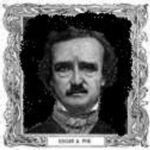Some of the greatest works in literature provides the reader with layers to examine. In addition to the outer level of a story, authors who provide subtext that reveal plot profundity achieve success in that the reader is compelled to analyze the story in greater depth. An example of this, Edgar Allan Poe’s “The Fall of the House of Usher” uses two metatexts that foreshadow the storyline while inviting the reader to ponder their inclusions as well as to make conclusions about their respective relevance to the original story.
Poe’s first inclusion of subtext is Usher’s poem. Usher’s poem is delivered as one of the “rhapsodies” the narrator vividly recalls, primarily due to “a full consciousness on the part of Usher” (Poe 92). As if overcome by madness, Usher is only able to communicate coherent thoughts through his “rhymed verbal improvisations” accompanied by the guitar. Usher’s ballad begins with praise for his “radiant palace” but reminds his listener that “This-all this- was in the olden/ Time long ago” (Poe 92). Yearning for his happy past, Usher is saddened to see the dismal state of his present condition. He admits “evil things…assailed the monarch’s high estate” (Poe 93). The reader can surmise the “evil” that Usher divulges in his sing-song rendition refers to the fallen state of Usher’s home. At this point in the narrative, the evil would appear to be caused by Lady Madeline’s incurable disease which would leave Usher “the last of the ancient race of Ushers” (Poe 90). Pondering the loneliness that accompanies being the last survivor, Usher obviously retreats to his memory in attempt to recall times that he was most content. As Usher harmonizes “the glory/ Is but a dim-remembered story” the reader is left to presume, in his descent into madness, Usher can hardly remember the happier days of the past (Poe 93).
After the ballad ends, the narrator shares the depth of Usher’s “disordered fancy” when he reveals Usher’s theory about the “sentience of all vegetable things” (Poe 93). By accusing the “fungi which overspread them, and of the decayed trees which stood around them” of being aware that they contribute to the home’s gloomy appearance, Usher’s theory of evil concludes the “evidence…was to be seen…in the gradual yet certain condensation of an atmosphere” (Poe 94). Usher’s theory also foreshadows the upcoming events which reveal the evil that resides in the home.
After Lady Madeline’s burial, the narrator attempts to entertain Usher by reading Sir Lancelot Canning’s Mad Trist . The events in Canning’s story repeatedly foreshadow the upcoming events in the Usher house. When Ethelred enters “by force…he so cracked, and ripped, and tore all asunder” to gain access to the hermit’s home, the narrator imagines the same sounds coming from the “remote parts of the mansion” (Poe 98). The narrator becomes more certain when he thinks, “I did actually hear…unusual screaming or grating sound- the exact counterpart of what my fancy had already conjured up for the dragon’s unnatural shriek” in the story (Poe 99). Poe uses Mad Trist to foreshadow the escape of Lady Madeline, building slow and deliberate fear for the reader.
Poe’s inclusion of the two subtexts builds the suspense of the plot. Inconspicuously foreshadowing the depth of Usher’s madness, Poe uses the poem to reveal the limitlessness of the abyss into which he has fallen. Further, Poe also uses Mad Trist to methodically expose the true evil that resides in and eventually causes the literal downfall of the house of Usher.





